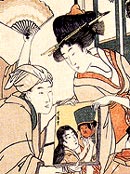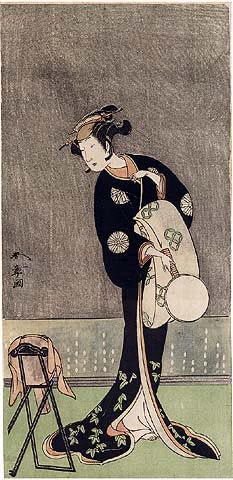

Deceptive Copies
|
|||||||||
 One of the notorious incidents during the early days of ukiyo-e collecting occurred in 1919, when an unscrupulous Japanese dealer (Hayashi Kyûgo; died 1947) sold revamped originals to the famous architect and print collector/dealer Frank Lloyd Wright. Revamping involved printing colors from recut wood blocks onto faded but otherwise genuine prints. Hayashi devised his scam with a Japanese collector named Takamizawa Enji (1870-1927,
One of the notorious incidents during the early days of ukiyo-e collecting occurred in 1919, when an unscrupulous Japanese dealer (Hayashi Kyûgo; died 1947) sold revamped originals to the famous architect and print collector/dealer Frank Lloyd Wright. Revamping involved printing colors from recut wood blocks onto faded but otherwise genuine prints. Hayashi devised his scam with a Japanese collector named Takamizawa Enji (1870-1927,
Takamizawa's copies still surface occasionally, including prints made from both recut key blocks and color blocks. The two impressions shown below of a design by Katsukawa Shunshô (c. 1723 - 1793) have been attributed to Takamizawa (also see the article by Roger Keyes cited in references). When making reproductions with the intention to deceive, copies are printed with colorants and techniques meant to imitate the appearance of aged originals. In this case, the figure of the actor Nakamura Noshio was copied from an original design circa 1773 (see figure at right; original impressions exist in the Art Institute of Chicago; the Sackler Museum, Harvard University; and the Musée Guimet, Paris). The background with a round lattice window was omitted from the copies.
In judging whether an impression is a copy, first compare the key block lines. Other factors may also provide corroborating evidence for the impression being a later copy. (Another possibility is that an impression might be an alternate state contemporaneous with the original; these were uncommon but are occasionally encountered). In the present case, the key block lines differ from the original. The commentary below summarizes the main points supporting the thesis that these impressions were not only copies but were also made to imitate aged original prints. As neither impression bears the seal of Takamizawa (whose firm also produced legitimate copies of old originals), it is uncertain whether they were sold as "originals" with the intent to deceive buyers, but clearly they were made in imitation of 18th-century prints.
| The two impressions shown below were made to imitate the typical aging patterns of ukiyo-e pigments; however, an inconsistency gives the game away. Notice the red pigment (probably meant to simulate beni from safflower) used for the underkimono and for the cloth that covers the mirror at the lower left. The orange-red color suggests that the original strong red has faded. Yet the blue on the lower part of the wall would also have been a fugitive color, almost always faded on 18th-century ukiyo-e prints. We should therefore expect that when the red is faded, so, too, should the blue. It would be highly unlikely that for such a rare design, multiple impressions would survive with so similar a pattern of partly faded blue pigment accompanied by substantial fading of the red. (Other similar copies of this same design are known in addition to the two illustrated here.) Notice, too, the simulated "tarnishing" on the back of the mirror in both examples, which is often encountered with this pink pigment. | |
 |
 |
| These details show the simulated patterns of fading for the blue pigment (probably meant to mimic aigami) on the lower wall. It is faded more on the far left on each impression, consistent with known fading patterns (due to the edges of the sheet receiving greater exposure to air and light, and especially humidity or moisture). The "tarnishing" on the back of the mirror is more pronounced in the impression at the left, but this is merely a printing variation. © 2001-2020 by John Fiorillo | |
 |
 |
BIBLIOGRAPHY
- Clark, T. and Ueda, O: The Actor's Image: Print Makers of the Katsukawa School. Art Institute of Chicago, 1994, p. 405, no. 279.
- Keyes, R. and Kühne, H.: "Tales the Woodblock Tell: Notes on Japanese Actor Prints of the Katsukawa School," in: Ukiyo-e Studies and Pleasures. Society for Japanese Arts and Crafts, The Hague, 1978, pp. 7-12, no. 8.
- Meech, J.: Frank Lloyd Wright and the Art of Japan: The Architect's Other Passion. New York, 2000, pp. 142-150 and 170.
Viewing Japanese Prints |